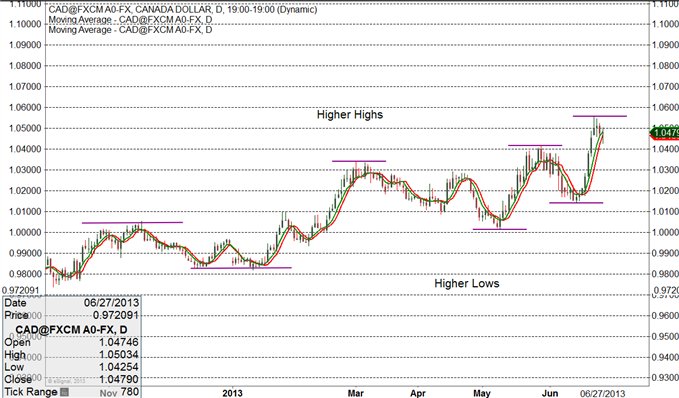5 Rules For Momentum & Trend Trading
5 Unbreakable Rules for Trend Trading
by Jay Norris
Long-term trends can be highly lucrative for astute traders who can correctly identify them and then properly manage their position - and their emotions - for the duration of the trade.
Believe What You See, Not What You Hear or Read
Trust that price and price patterns price are accurate reflections of the underlying fundamentals and sentiment. We won't see sustained price movement without supporting economics. However, given the large amount of information on the Internet today, it is too easy to think there is a logical explanation for every micro move the market produces.
The reasons why large traders or funds enter or exit trades are generally known only to them, and even those traders will second guess themselves. Do not read too much into the analysis of intraday price reactions that are tied to short-term news releases. Instead, trust that at the end of the day, week, etc., price action will have gotten it right.
As you can see below, the current price pattern on the chart is showing a clear pattern of higher lows and higher highs. Traders must regard that information as being more valuable than what is said or written about the market.
Higher Highs, Lower Lows Chart

Don't Overemphasize Market Correlations
There will be days when a trending asset like the US dollar (USD) (USO) is strong and the US stock market is weak, and there will also be days when both are moving in sync. Bonds and their supposed relation to other markets or assets can be especially tempting as well.
Do not try to outguess the market or time it based on yesterday's correlations. There's no doubt that markets are similar to people in that they are social entities where large movement in one can-and often will-affect the behavior of another. But just as people's habits change, so too will market correlations, and it is better not to rely on correlations staying the same.
Learn to Set it and Forget it
There is no amount of advice that can prepare traders for the temptation of exiting a trade too soon, or conversely, ignoring money-management rules in order to maximize profits. Trading is the most intense self-examination there is, and no matter how prepared you think you are, there's always room to learn and grow.
The hardest thing you will ever learn in trading is simply to let a profit run. Once in the trade, set your stop loss (preferably further back than you initially think) and try to forget about the trade altogether.
Do not think that you overlooked something in your analysis, do not search out articles to support your thesis, and do not look at the trade every few minutes. In other words, do not dig up the seed to see if it is growing.
Buy Dips in Uptrends and Sell Rallies in Downtrends
This is the "golden rule" of trading and the first thing we learn on a trading floor. No matter the strength of a trend, there will always be intraday or intraweek countertrend reactions that provide opportunities for astute traders. Often times, these countertrend moves follow news which contradicts the prevailing pattern or trend.
Always know when influential news releases are scheduled, because when the news itself it counter to the overall pattern, a countertrend move will generally follow because shorter-term traders get scared out of their positions. This generally leads to an opportunity to buy a dip in the uptrend, or sell a rally in the downtrend.
Don't Try to Pick the Top or Bottom
While many of us want to pick the top or bottom in a market because we perceive less risk, the truth is that professional traders simply want to participate in the top third of a move because that is when the rewards are greatest and occur fastest.
The majority of professional traders rely on some measure of momentum to time their trades. We prefer two types of triggers: 1) zone trades, where we are buying or selling at support or resistance; and 2) momentum trades, where we are buying based on overall pattern and shorter-term momentum.
Over the course of the day, we see many more momentum trades than zone trades, and our risk is also lower for the momentum trades, so we trade those larger. While "Buy low, sell high" is good advice, for momentum traders, the best advice is "Buy high, sell higher."
Courtesy of dailyfx.com
